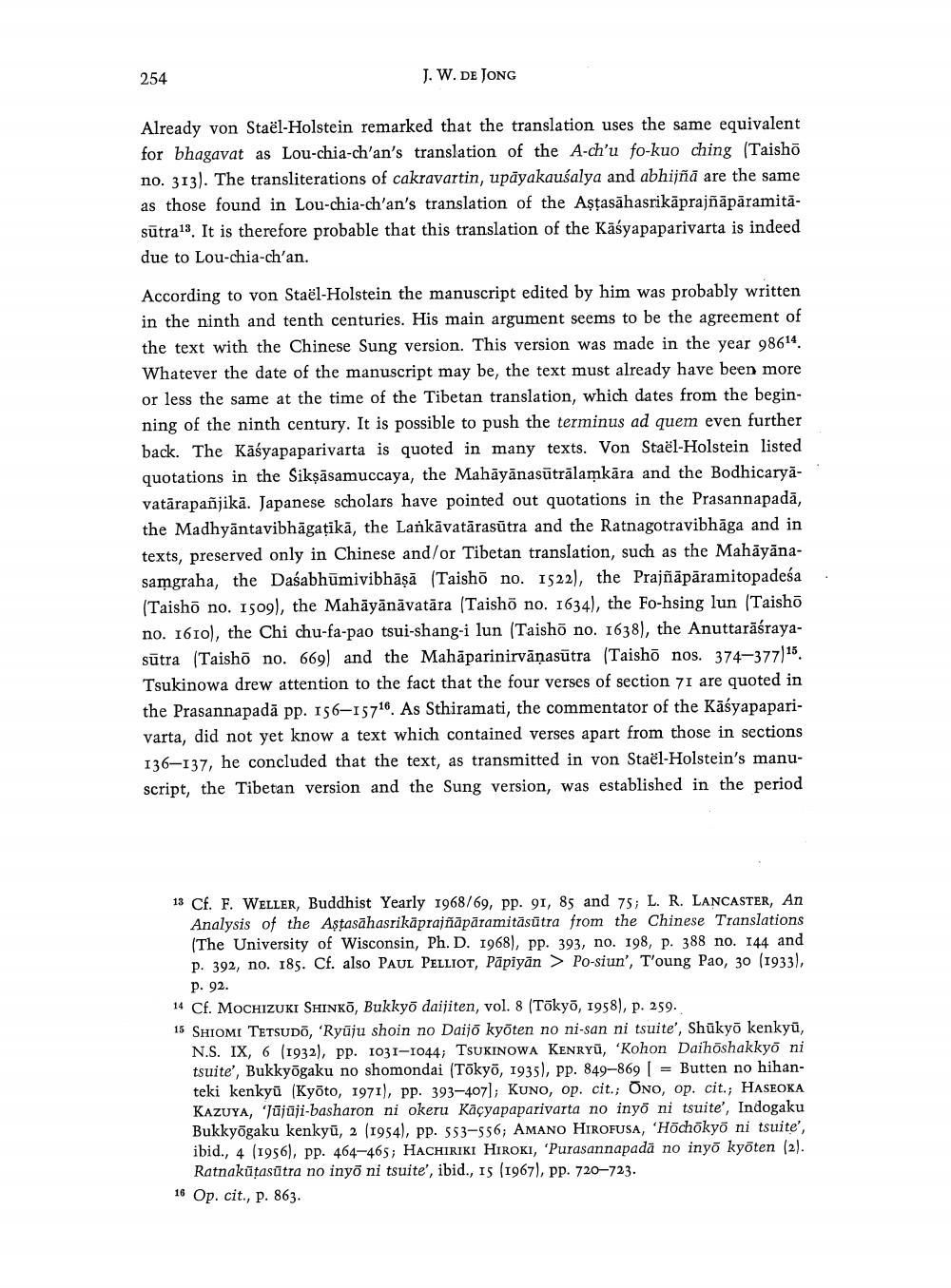________________
254
J. W. DE JONG
Already von Staël-Holstein remarked that the translation uses the same equivalent for bhagavat as Lou-chia-ch'an's translation of the A-ch'u fo-kuo ching (Taisho no. 313). The transliterations of cakravartin, upāyakausalya and abhijñā are the same as those found in Lou-chia-ch'an's translation of the Așțasāhasrikāprajñāpāramitasūtra13. It is therefore probable that this translation of the Kaśyapaparivarta is indeed due to Lou-chia-ch'an.
According to von Staël-Holstein the manuscript edited by him was probably written in the ninth and tenth centuries. His main argument seems to be the agreement of the text with the Chinese Sung version. This version was made in the year 98614. Whatever the date of the manuscript may be, the text must already have been more or less the same at the time of the Tibetan translation, which dates from the beginning of the ninth century. It is possible to push the terminus ad quem even further back. The Kāśyapaparivarta is quoted in many texts. Von Staël-Holstein listed quotations in the Sikşāsamuccaya, the Mahāyānasūtrālamkāra and the Bodhicaryāvatārapañjikā. Japanese scholars have pointed out quotations in the Prasannapadā, the Madhyāntavibhāgaţikā, the Lankävatārasūtra and the Ratnagotravibhāga and in texts, preserved only in Chinese and/or Tibetan translation, such as the Mahāyānasamgraha, the Daśabhūmivibhāṣā (Taisho no. 1522), the Prajñāpāramitopadeśa (Taisho no. 1509), the Mahāyānāvatāra (Taishō no. 1634), the Fo-hsing lun (Taisho no. 1610), the Chi chu-fa-pao tsui-shang-i lun (Taishō no. 1638), the Anuttarāśrayasūtra (Taisho no. 669) and the Mahāparinirvāṇasūtra (Taisho nos. 374-377)15. Tsukinowa drew attention to the fact that the four verses of section 71 are quoted in the Prasannapadā pp. 156–15716. As Sthiramati, the commentator of the Kāśyapaparivarta, did not yet know a text which contained verses apart from those in sections 136-137, he concluded that the text, as transmitted in von Staël-Holstein's manuscript, the Tibetan version and the Sung version, was established in the period
13 Cf. F. Weller, Buddhist Yearly 1968/69, pp. 91, 85 and 75, L. R. LANCASTER, An
Analysis of the Astasāhasrikāprajñāpāramitāsūtra from the Chinese Translations (The University of Wisconsin, Ph. D. 1968), pp. 393, no. 198, p. 388 no. 144 and p. 392, no. 185. Cf. also PAUL PELLIOT, Pāpiyān > Po-siun', T'oung Pao, 30 (1933),
p. 92. 14 Cf. MOCHIZUKI SHINKO, Bukkyo daijiten, vol. 8 (Tōkyō, 1958), p. 259. 15 SHIOMI TETSUDŌ, 'Ryūju shoin no Daijo kyõten no ni-san ni tsuite', Shūkyo kenkyū,
N.S. IX, 6 (1932), pp. 1031–1044; TSUKINOWA KENRYŪ, Kohon Daihoshakkyo ni tsuite', Bukkyōgaku no shomondai (Tokyo, 1935), pp. 849-869 | = Butten no hihanteki kenkyū (Kyoto, 1971), pp. 393-407); KUNO, op. cit.; ONO, op. cit.; HASEOKA KAZUYA, Jūjūji-basharon ni okeru Kaçyapaparivarta no inyo ni tsuite', Indogaku Bukkyōgaku kenkyū, 2 (1954), pp. 553-556; AMANO HIROFUSA, 'Höchōkyō ni tsuite', ibid., 4 (1956), pp. 464-465; HACHIRIKI HIROKI, 'Purasannapada no inyo kyõten (2).
Ratnakūtasutra no inyo ni tsuite', ibid., 15 (1967), pp. 720-723. 16 Op. cit., p. 863.




